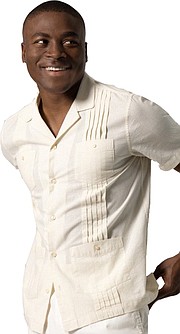IN The Bahamas and Jamaica, we call it the bush jacket. In the Dominican Republic it is commonly known as the chacabana shirt. In Haiti, it is sometimes called the guyabel, while in Trinidad and Tobago and Guyana, it is often referred to as the shirt-jac.
But throughout much of Latin America, especially in Cuba and Mexico, where the history and fashion of the shirt are mostly derived, it is known as the guayabera. While the origin of the name is debated, one storyline suggests that it is derived from the Spanish word, “guayaba” or “guava”.
Distinguished by its “two vertical stripes of pleating and/or embroidery” on the front and a bottom straight cut, [the guayabera is one of] the most iconic piece[s] of clothing associated with the cultural life of Latin American and Caribbean populations worldwide.” The shirt is worn outside of the pants.
The pleats of the guayabera run the length of the front and back of the shirt, which is typically made of cotton, linen or silk. Some shirts have two pleats in the front and one in the back.
Many of the shirts, though not all, have four front pockets. Nowadays, many of the more dressed guayaberas are sans pockets. There are long and short sleeve shirts, with the latter, cuffed.
Though initially designed for men, there are female versions, and even miniature shirts designed for stuffed animals, like Teddy Bears.
Though the shirt was traditionally white or pastel, they are available in a rainbow of colours, often with elaborate embroidery. In Mexico, black guayaberas, adorned with colourful embroidered flowers and French cuffs are popular as formal wear for some occasions.
In 2019, Cuba reinstated the shirt as its “official formal dress garment”. Guayaberas are formal wear for offices and special occasions through much of Latin and Central America and the Caribbean.
In Belize, which has been described as “the Caribbean beat in the heart of Central America”, the guayabera is formal wear for offices, including government offices. It is worn by members of the House of Representatives during sittings and by the prime minister and cabinet ministers on a daily basis, including for state occasions.
Some Belizeans have their long sleeve guayaberas tailored, sometimes with intricate patterns, including Mayan symbolism. Such shirts, pun intended, can cost a pretty penny.
In the Americas, the shirts are found at mass market stores as well as in high-end shops, including in Florida where a gentleman may have his shirts crafted by expert Cuban tailors.
The guayabera has gone global, with a more diverse customer base, and may be found online and in boutique and department stores. “Fashion designers are introducing new fabric types and styles, as well as new imaginative designs.”
There are many threads to weave to recount the history of the guayabera. Some suggest that the original design was derived from the lace-like white Philippine barong tagalog, making its way from that country to the Americas, specifically Acapulco, Mexico, and to Cuba.
Others dispute that connection, noting the differences in the shirts. Another narrative is that the shirt was popularised in Cuba, resembling uniforms worn by Spanish and Cuban soldiers, while “other sources describe its use in the countryside by Cuban landowners and fieldworkers”.
Just as there is a rich social history to the shirt, there is also a more modern history. Mexican and Cuban leaders wore the guayabera as both a fashion and political statement, donning the shirts instead of a coat and tie, which they believed were too colonial.
The design and production of the shirts provided domestic sources of work, income and industry, uncontrolled by First World corporations and manufacturers. Wearing a guayabera was also more practical in warmer climates.
The guayabera was worn by leaders and activists such as Cesar Chavez, Fidel Castro, Belizean Founding Father George Price, and Jamaican Prime Minister Michael Manley.
“Manley specifically advocated for the guayabera as an anti-colonialist mode of dress, and conversely the shirt was later banned in Parliament by the conservative Jamaica Labour Party.”
Though the shirt was a symbol in some leftist quarters, its practicality and cultural roots and resonance led to the widespread dispersion of the guayabera throughout Latin America and the Caribbean, with the shirt now worn by people of all political persuasions, ethnicities and economic and social circumstances.
Whatever the historic origins, the guayabera made its way to the Yucatan peninsula. There is a textured and interwoven history between Mexico and Cuba in general, and in particular between Cuba and Merida, the capital of the Yucatan, atop the northern end of the Yucatan Peninsula adjoining the Gulf of Mexico.
Merida, a city of approximately 900,000, enjoys a rich Mayan and colonial heritage. Today, it is one of the world’s capitals and leading producers of the guayabera, which are ubiquitous, with a dazzling array of shirts available in markets, department stores and boutique shops.
There is much that Mexicans and Cubans can teach other countries, including The Bahamas, about the design and commercial possibilities of the guayabera. Bahamians of a certain generation may recall that wearing the shirt became widespread in the 1970s.
Bahamians studying in the region, including at the University of the West Indies, returned home wearing bush jackets. The shirt became daily wear for many priests and religious ministers, as well as Bahamian and West Indian teachers.
Many men, who did not like the restrictions of the coat and tie, welcomed the introduction of the guayabera, which was cooler to wear, less expensive and easy to maintain.
The bush jacket was the signature shirt worn by cultural giants like the composer and Director of Culture, E Clement Bethel, and the multitalented cultural advocate and founder of Jumbey Village, Edmund Moxey.
Scores of men and boys wore the shirt to church, in some offices and at various social and special events. Every Bahamian prime minister and a good number of governors general have worn the shirt on occasion.
Amidst climate change, and a greater focus on the creative economy and economic diversification, the guayabera should have a promising and bright future!
Many men around the world are wearing ties much less. The Speaker of the lower house of the Australian Parliament recently ruled that male members need no longer wear a tie with their jacket.
Parliaments make their own rules on appropriate attire for members. It is time for The Bahamas Parliament to allow male members to wear appropriate long sleeve, cuffed guayaberas in Parliament. This could lead to more Bahamian men wearing formal and appropriate guayaberas daily in office settings.
It has become swelteringly ridiculous to see men in 90-degree weather going to work in coats and ties, while sweating profusely. More schools might move toward the guayabera as the uniform for boys, ditching the tie year-round and not just during warmer months.
Imagine cabinet meetings during which most members and officials were now wearing guayaberas. Anything to cool the passions of sometimes hot-under-the-collar politicians and executives would be welcomed by most Bahamians.
In addition to commercial benefits, the wearing of guayaberas by more men on more occasions might offer Bahamians a greater sensitivity about our ties to our region. Shirts embroidered with Bahamian designs could be sold to tourists and given as gifts to visiting diplomats and guests.
These guayaberas, long and short sleeve, may come in an archipelago of colours of the land and sea, including colours derived from pulp of the guinep, the juicy inside of a Bahamian guava or mango, the shell of a cooked crawfish, the many shades of jade and aqua of our waters, and others from our palette of flora.
Further, as the climate continues to warm and energy costs continue to rise, the Government of The Bahamas should move to a full fleet of electric cars.
Though there are already hybrids and some electric cars in the fleet, the Government can decrease its huge gas bill and demonstrate its commitment to reducing carbon emissions by setting targets for moving to a full electric fleet throughout the country.
Moreover, why are we still buying black or darker coloured cars for cabinet ministers, permanent secretaries and other senior officials in a tropical Bahamas? In Australia, the prime minister’s official car is white.
The fashion we wear and the objects of daily life demonstrate our consciousness and sense of the times, especially certain signs of the times, like climate change.
In promoting more climate-appropriate fashions and modes of transportation, we might design and offer to ourselves a powerful cultural cum fashion statement about a more sustainable and environmentally conscious future.






Comments
ThisIsOurs 1 year, 7 months ago
"It has become swelteringly ridiculous to see men in 90-degree weather going to work in coats and ties, while sweating profusely."
Have thought this for years. I recall seeing a Bahamian contingent arrive for a special occasion on anotger Caribbean island, in the 90 degree heat, with all the women wearing weaves, tons of makeup, stockings and heavy suits. Meanwhile the local Caribbean contingent wore natural hair styles, were sans stockings and much lighter apparel. And of course the Bahamians turned up their noses at the troglodytes who didnt know how to dress. This was 20 years ago.
We treasure style over sense on so many levels in this country thats why so many politicians, senior ministers, govt officials, men and women on the street destroy themselves chasing money at any cost.
Sign in to comment
Or login with:
OpenID